|

by Jeffrey M. Smith
January 28, 2011
from
NaturalNews Website
|
About the author
International bestselling author and filmmaker Jeffrey M. Smith is
the executive director of the Institute for Responsible Technology.
His first book, Seeds of Deception: Exposing Industry and Government
Lies About the Safety of the Genetically Engineered Foods You're
Eating,
is the world's bestselling and #1 rated book on GMOs.
His
second, Genetic Roulette: The Documented Health Risks of Genetically
Engineered Foods, documents 65 health risks of the GM foods
Americans eat everyday.
To help you choose healthier, non-GMO
brands, use the Non-GMO Shopping Guide.
|
The following article reveals the
devastating and unprecedented impact that Monsanto's Roundup
herbicide is having on the health of our soil, plants, animals, and
human population.
On top of this perfect storm, the USDA now wants to approve Roundup
Ready alfalfa, which will exacerbate this calamity.
Please
tell USDA
Secretary Vilsack not to approve Monsanto's alfalfa today. [Note:
typos corrected from Jan 16th,
see details]
While visiting a seed corn dealer's demonstration plots in Iowa last
fall, Dr. Don Huber walked passed a soybean field and noticed a
distinct line separating severely diseased yellowing soybeans on the
right from healthy green plants on the left (see photo).
The yellow section was suffering from Sudden Death Syndrome (SDS), a
serious plant disease that ravaged the Midwest in 2009 and '10,
driving down yields and profits.
Something had caused that area of
soybeans to be highly susceptible and Don had a good idea what it
was.
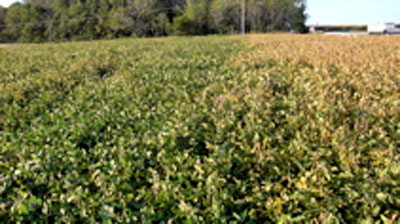
The diseased field on
the right had glyphosate applied the previous season.
Photo by Don Huber
Don Huber spent 35 years as a plant
pathologist at Purdue University and knows a lot about what causes
green plants to turn yellow and die prematurely.
He asked the seed
dealer why the SDS was so severe in the one area of the field and
not the other.
"Did you plant something there last year that wasn't
planted in the rest of the field?" he asked.
Sure enough, precisely
where the severe SDS was, the dealer had grown alfalfa, which he
later killed off at the end of the season by spraying a glyphosate-based
herbicide (such as Roundup).
The healthy part of the field, on the
other hand, had been planted to sweet corn and hadn't received
glyphosate.
This was yet another confirmation that Roundup was triggering SDS.
In many fields, the evidence is even more obvious. The disease was
most severe at the ends of rows where the herbicide applicator
looped back to make another pass (see photo). That's where extra
Roundup was applied.
Don's a scientist; it takes more than a few photos for him to draw
conclusions. But Don's got more - lots more. For over 20 years, Don
studied Roundup's active ingredient glyphosate. He's one of the
world's experts.
And he can rattle off study after study that
eliminate any doubt that glyphosate is contributing not only to the
huge increase in SDS, but to the outbreak of numerous other
diseases. (See
selected reading list.)

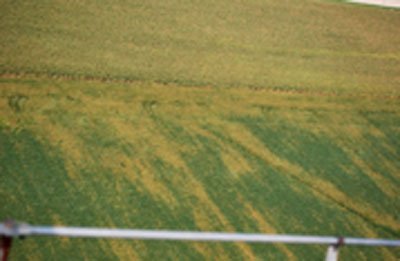
Sudden Death Syndrome
is more severe at the ends of rows, where Roundup dose is strongest.
Photo by Amy Bandy.
Roundup - The
perfect storm for plant disease
More than
30% of all herbicides sprayed anywhere contain glyphosate
- the
world's bestselling weed killer.
It was patented by
Monsanto for use
in their Roundup brand, which became more popular when they
introduced "Roundup Ready" crops starting in 1996. These
genetically
modified (GM) plants, which now include soy, corn, cotton, canola,
and sugar beets, have inserted genetic material from viruses and
bacteria that allows the crops to withstand applications of normally
deadly Roundup.
(Monsanto incentivizes farmers who buy
Roundup Ready seeds to also
use the company's Roundup brand of glyphosate. For example, they
only provide warranties on the approved herbicide brands and offer
discounts through their "Roundup Rewards" program. This has extended
the company's grip on the glyphosate market, even after its patent
expired in 2000.)
The herbicide doesn't destroy plants directly. It rather cooks up a
unique perfect storm of conditions that revs up disease-causing
organisms in the soil, and at the same time wipes out plant defenses
against those diseases. The mechanisms are well-documented but
rarely cited.
The glyphosate molecule grabs vital nutrients and doesn't let them
go.
This process is called
chelation and was actually the original
property for which glyphosate was patented in 1964. It was only 10
years later that it was patented as an herbicide. When applied to
crops, it deprives them of vital minerals necessary for healthy
plant function - especially for resisting serious soilborne diseases.
The importance of minerals for protecting against disease is well
established. In fact, mineral availability was the single most
important measurement used by several famous plant breeders to
identify disease-resistant varieties.
Glyphosate annihilates beneficial soil organisms, such as
Pseudomonas and Bacillus bacteria that live around the roots. Since
they facilitate the uptake of plant nutrients and suppress
disease-causing organisms, their untimely deaths means the plant
gets even weaker and the pathogens even stronger.
The herbicide can interfere with photosynthesis, reduce water use
efficiency, lower lignin, damage and shorten root systems, cause
plants to release important sugars, and change soil pH - all of which
can negatively affect crop health.
Glyphosate itself is slightly toxic to plants. It also breaks down
slowly in soil to form another chemical called AMPA (aminomethylphosphonic
acid) which is also toxic. But even the combined toxic effects of
glyphosate and AMPA are not sufficient on their own to kill plants.
It has been demonstrated numerous times since 1984 that when glyphosate is applied in sterile soil, the plant may be slightly
stunted, but it isn't killed (see photo).
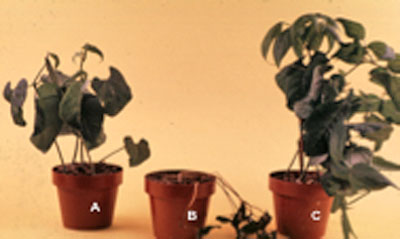
Glyphosate with
sterile soil (A) only stunts plant growth. In normal soil (B),
pathogens kill the plant.
Control (C) shows
normal growth.
The actual plant assassins, according to
Purdue weed scientists and others, are severe disease-causing
organisms present in almost all soils.
Glyphosate dramatically
promotes these, which in turn overrun the weakened crops with deadly
infections.
"This is the herbicidal mode of action of glyphosate," says Don. "It
increases susceptibility to disease, suppresses natural disease
controls such as beneficial organisms, and promotes virulence of soilborne pathogens at the same time."
In fact, he points out that,
"If you apply certain fungicides to weeds, it destroys the
herbicidal activity of glyphosate!"
By weakening plants and promoting disease, glyphosate opens the door
for lots of problems in the field.
According to Don,
"There are more
than 40 diseases of crop plants that are reported to increase with
the use of glyphosate, and that number keeps growing as people
recognize the association between glyphosate and disease."
Roundup
promotes human and animal toxins
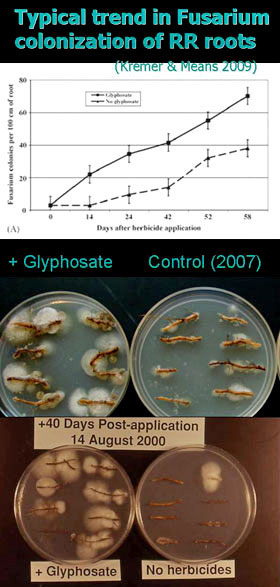
Photo by Robert
Kremer
Some of the fungi promoted by glyphosate
produce dangerous toxins that can end up in food and feed. Sudden
Death Syndrome, for example, is caused by the
Fusarium fungus.
USDA
scientist Robert Kremer found a 500% increase in Fusarium root
infection of Roundup Ready soybeans when glyphosate is applied (see
photos and chart). Corn, wheat, and many other plants can also
suffer from serious Fusarium-based diseases.
But Fusarium's wrath is not limited to plants.
According to
a report
by the UN Food and Agriculture Organization (FAO), toxins from Fusarium on
various types of food crops have been associated with disease
outbreaks throughout history.
They've "been linked to the plague
epidemics" of medieval Europe, "large-scale human toxicosis in
Eastern Europe," oesophageal cancer in southern Africa and parts of
China, joint diseases in Asia and southern Africa, and a blood
disorder in Russia.
Fusarium toxins have also been shown to cause
animal diseases and induce infertility.
As Roundup use
rises, plant disease skyrockets
When Roundup Ready crops were introduced in 1996,
Monsanto boldly
claimed that herbicide use would drop as a result. It
did - slightly - for three years. But over the next 10 years, it grew
considerably.
Total herbicide use in the US jumped by a whopping 383
million pounds in the 13 years after
GMOs came on the scene. The greatest contributor is Roundup.
Over time, many types of weeds that would once keel over with just a
tiny dose of Roundup now require heavier and heavier applications.
Some are nearly invincible. In reality, these super-weeds are
resistant not to the glyphosate itself, but to the soilborne
pathogens that normally do the killing in Roundup sprayed fields.
Having hundreds of thousands of acres infested with weeds that
resist plant disease and weed killer has been devastating to many US
farmers, whose first response is to pour on more and more Roundup.
Its use is now accelerating. Nearly half of the huge 13-year
increase in herbicide use took place in just the last 2 years.
This
has serious implications.
As US farmers drench more than 135 million acres of Roundup Ready
crops with Roundup, plant diseases are enjoying an unprecedented
explosion across America's most productive crop lands. Don rattles
off a lengthy list of diseases that were once under effective
management and control, but are now creating severe hardship.
(The
list includes SDS and Corynespora root rot of soybeans, citrus
variegated chlorosis (CVC), Fusarium wilt of cotton, Verticillium
wilt of potato, take-all root, crown, and stem blight of cereals,
Fusarium root and crown rot, Fusarium head blight, Pythium root rot
and damping off, Goss' wilt of corn, and many more.)
In Brazil, the new "Mad Soy Disease" is ravaging huge tracts of
soybean acreage.
Although scientists have not yet determined its
cause, Don points out that various symptoms resemble a rice disease
(bakanae) which is caused by Fusarium.
Corn dies
young
In recent years, corn plants and entire fields in the Midwest have
been dying earlier and earlier due to various diseases.
Seasoned and
observant farmers say they're never seen anything like it.
"A decade ago, corn plants remained green and healthy well into
September," says Bob Streit, an agronomist in Iowa.
"But over the
last three years, diseases have turned the plants yellow, then
brown, about 8 to 10 days earlier each season. In 2010, yellowing
started around July 7th and yield losses were devastating for many
growers."
Bob and other crop experts believe that the increased use of
glyphosate is the primary contributor to this disease trend. It has
already reduced corn yields significantly.
"If the corn dies much
earlier," says Bob, "it might collapse the corn harvest in the US,
and threaten the food chain that it supports."
A question of
bugs
In addition to promoting plant diseases, which is well-established,
spraying Roundup might also promote insects.
That's because many
bugs seek sick plants. Scientists point out that healthy plants
produce nutrients in a form that many insects cannot assimilate.
Thus, farmers around the world report less insect problems among
high quality, nutrient-dense crops. Weaker plants, on the other
hand, create insect smorgasbords.
This suggests that plants ravaged
with diseases promoted by glyphosate may also attract more insects,
which in turn will increase the use of toxic pesticides.
More study
is needed to confirm this.
Roundup
persists in the environment
Monsanto used to boast that Roundup is biodegradable, claiming that
it breaks down quickly in the soil.
But courts in the US and Europe
disagreed and found them guilty of false advertising. In fact,
Monsanto's own test data revealed that only 2% of the product broke
down after 28 days.
Whether glyphosate degrades in weeks, months, or years varies widely
due to factors in the soil, including pH, clay, types of minerals,
residues from Roundup Ready crops, and the presence of the
specialized enzymes needed to break down the herbicide molecule. In
some conditions, glyphosate can grab hold of soil nutrients and
remain stable for long periods.
One study showed that it took up to
22 years for glyphosate to degrade only half its volume!
So much for
trusting Monsanto's product claims.
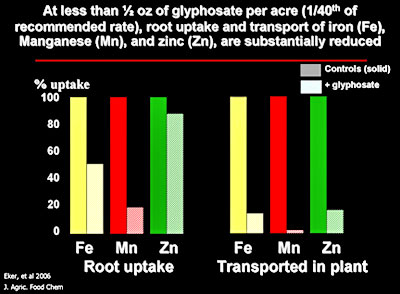
Glyphosate can attack from above and
below. It can drift over from a neighbors farm and wreak havoc. And
it can even be released from dying weeds, travel through the soil,
and then be taken up by healthy crops.
The amount of glyphosate that can cause damage is tiny. European
scientists demonstrated that less than half an ounce per acre
inhibits the ability of plants to take up and transport essential
micronutrients (see chart).
As a result, more and more farmers are finding that crops planted in
years after Roundup is applied suffer from weakened defenses and
increased soilborne diseases.
The situation is getting worse for
many reasons.
-
The glyphosate concentration in the soil builds up season after
season with each subsequent application.
-
Glyphosate can also
accumulate for 6-8 years inside perennial plants like alfalfa, which
get sprayed over and over.
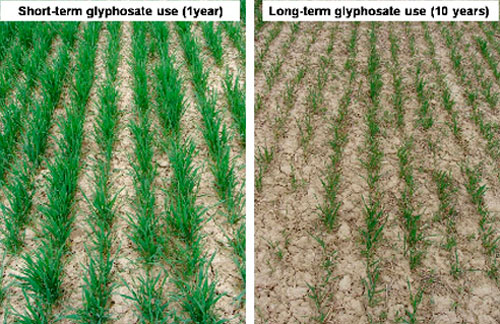
Wheat affected after
10 years of glyphosate field applications.
-
Glyphosate residues in the soil that
become bound and immobilized can be reactivated by the application
of phosphate fertilizers or through other methods. Potato growers in
the West and Midwest, for example, have experienced severe losses
from glyphosate that has been reactivated.
-
Glyphosate can find its way onto farmland accidentally, through
drifting spray, in
contaminated water, and even through chicken
manure!
Imagine the shock of farmers who spread chicken manure in their
fields to add nutrients, but instead found that the glyphosate in
the manure tied up nutrients in the soil, promoted plant disease,
and killed off weeds or crops.
Test results of the manure showed glyphosate/AMPA concentrations at a whopping 0.36-0.75 parts per
million (ppm). The normal herbicidal rate of glyphosate is about 0.5
ppm/acre.
Manure from other animals may also be spreading the herbicide, since
US livestock consume copious amounts of glyphosate - which
accumulates in corn kernels and soybeans. If it isn't found in
livestock manure (or urine), that may be even worse. If glyphosate
is not exiting the animal, it must be accumulating with every meal,
ending up in our meat and possibly milk.
Add this threat to the already high glyphosate residues inside our
own diets due to corn and soybeans, and we have yet another serious
problem threatening our health.
Glyphosate has been linked to
sterility, hormone disruption, abnormal and lower sperm counts,
miscarriages, placental cell death, birth defects, and cancer, to
name a few. (See
resource list on glyphosate health effects.)
Nutrient loss
in humans and animals
The same nutrients that glyphosate chelates and deprives plants are
also vital for human and animal health.
These include iron, zinc,
copper, manganese, magnesium, calcium, boron, and others.
Deficiencies of these elements in our diets, alone or in
combination, are known to interfere with vital enzyme systems and
cause a long list of disorders and diseases.
Alzheimer's, for example, is linked with reduced copper and
magnesium. Don Huber points out that this disease has jumped 9000%
since 1990.
Manganese, zinc, and copper are also vital for proper functioning of
the SOD (superoxide dismutase) cycle. This is key for stemming
inflammation and is an important component in detoxifying unwanted
chemical compounds in humans and animals.
Glyphosate-induced mineral deficiencies can easily go unidentified
and untreated. Even when laboratory tests are done, they can
sometimes detect adequate mineral levels, but miss the fact that
glyphosate has already rendered them unusable.
Glyphosate can tie up minerals for years and years, essentially
removing them from the pool of nutrients available for plants,
animals, and humans.
If we combine the more than 135 million pounds
of glyphosate-based herbicides applied in the US in 2010 with total
applications over the past 30 years, we may have already eliminated
millions of pounds of nutrients from our food supply.
This loss is something we simply can't afford. We're already
suffering from progressive nutrient deprivation even without
Roundup.
In a UK study, for example, they found between 16-76% less
nutrients in 1991, compared to levels in the same foods in 1940.
Livestock
disease and mineral deficiency
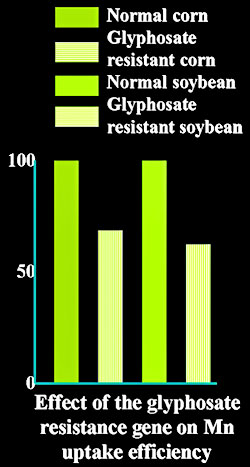
Roundup Ready crops dominate US
livestock feed.
Soy and corn are most prevalent - 93% of US soy and
nearly 70% of corn are Roundup Ready. Animals are also fed
derivatives of the other three Roundup Ready crops: canola, sugar
beets, and cottonseed. Nutrient loss from glyphosate can therefore
be severe.
This is especially true for manganese (Mn), which is not only
chelated by glyphosate, but also reduced in Roundup Ready plants
(see photo). One veterinarian finds low manganese in every livestock
liver he measures. Another vet sent the liver of a stillborn calf
out for testing.
The lab report stated:
No Detectible Levels of
Manganese - in spite of the fact that the mineral was in adequate
concentrations in his region.
When that vet started adding manganese
to the feed of a herd, disease rates dropped from a staggering 20%
to less than?.
Veterinarians who started their practice after GMOs were introduced
in 1996 might assume that many chronic or acute animal disorders are
common and to be expected. But several older vets have stated flat
out that animals have gotten much sicker since GMOs came on the
scene. And when they switch livestock from GMO to non-GMO feed, the
improvement in health is dramatic.
Unfortunately, no one is tracking
this, nor is anyone looking at the impacts of consuming milk and
meat from GM-fed animals.
Alfalfa
madness, brought to you by Monsanto and the USDA
As we continue to drench our fields with Roundup, the perfect storm
gets bigger and bigger.
Don asks the sobering question:
"How much of
the hundreds of millions of pounds of glyphosate that have been
applied to our most productive farm soils over the past 30 years is
still available to damage subsequent crops through its effects on
nutrient availability, increased disease, or reduced nutrient of our
food and feed?"
Instead of taking urgent steps to protect our land and food, the
USDA just made plans to make things worse.
In December they released
their Environmental Impact Statement (EIS) on Roundup Ready alfalfa,
which
Monsanto hopes to reintroduce to the market.
Alfalfa is the fourth largest crop in the US, grown on 22 million
acres. It is used primarily as a high protein source to feed dairy
cattle and other ruminant animals. At present, weeds are not a big
deal for alfalfa. Only 7% of alfalfa acreage is ever sprayed with an
herbicide of any kind. If Roundup Ready alfalfa is approved,
however, herbicide use would jump to unprecedented levels, and the
weed killer of choice would of course be Roundup.
Even without the application of glyphosate, the nutritional quality
of Roundup Ready alfalfa will be less, since Roundup Ready crops, by
their nature, have reduced mineral.
When glyphosate is applied,
nutrient quality suffers even more (see chart).
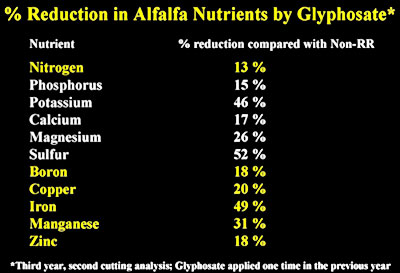
The chance that Roundup would increase
soilborne diseases in alfalfa fields is a near certainty. In fact,
Alfalfa may suffer more than other Roundup Ready crops. As a
perennial, it can accumulate Roundup year after year.
It is a
deep-rooted plant, and glyphosate leaches into sub soils.
And "Fusarium
is a very serious pathogen of alfalfa," says Don.
"So too are Phytophthora and Pythium," both of which are promoted by glyphosate.
"Why would you even consider jeopardizing the productivity and
nutrient quality of the third most valuable crop in the US?" he asks
in frustration, "especially since we have no way of removing the
gene once it is spread throughout the alfalfa gene pool."
It's already spreading.
Monsanto had marketed Roundup Ready alfalfa
for a year, until a federal court declared its approval to be
illegal in 2007. They demanded that the USDA produce an EIS in order
to account for possible environmental damage. But even with the
seeds taken off the market, the RR alfalfa that had already been
planted has been contaminating non-GMO varieties.
Cal/West Seeds,
for example, discovered that more than 12% of their seed lots tested
positive for contamination in 2009, up from 3% in 2008.
In their EIS, the USDA does acknowledge that genetically modified
alfalfa can contaminate organic and non-GMO alfalfa, and that this
could create economic hardship. They are even considering the
unprecedented step of placing restrictions on RR alfalfa seed
fields, requiring isolation distances.
Experience suggests that this
will slow down, but not eliminate GMO contamination.
Furthermore,
studies confirm that genes do transfer from GM crops into soil and
soil organisms, and can jump into fungus through cuts on the surface
of GM plants. But the EIS does not adequately address these threats
and their implications.
Instead, the USDA largely marches lock-step with the biotech
industry and turns a blind eye to the widespread harm that Roundup
is already inflicting. If they decide to approve Monsanto's alfalfa,
the USDA may ultimately be blamed for a catastrophe of epic
proportions.
Please
send a letter to USDA Secretary
Tom Vilsack, urging him not
to approve Roundup Ready alfalfa, and to fully investigate the
damage that Roundup and GMOs are already inflicting.
|









